

Anders Wästfelt dressed up in 17th century soldiers gear,
as befitted to present the New Elfsborg Castle.
Photo: Jan-Erik Nilsson
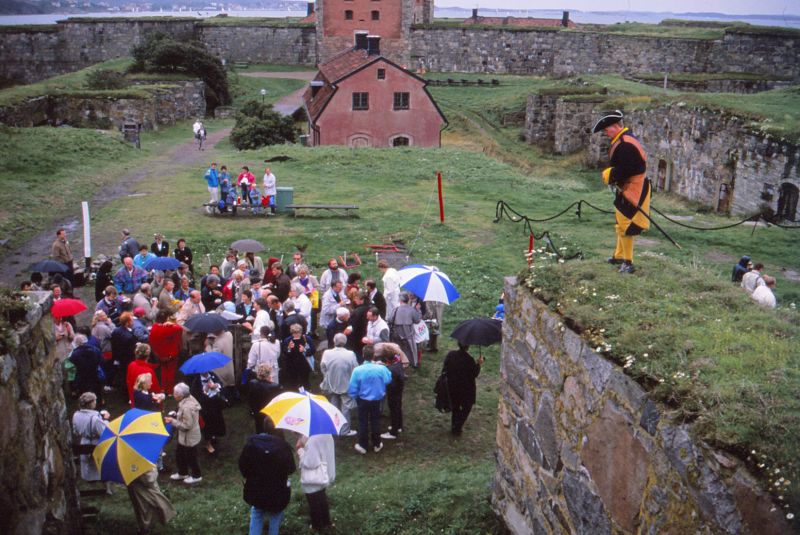
Anders, preparing to talk to a visiting crowd, invited
by the antiques dealer Björn Gremner of AntikWest.
In the 12th of September 1745 the East Indiaman Götheborg - the pride of the Swedish East India Company - had approached the home harbor of Gothenburg, Sweden with pilot on board and with favorable winds coming in from the aft. For some still unexplainable reasons the largest vessel in the entire fleet of the Swedish East India Company now hit the well known Hunnebådan reef, and sank in the very river mouth of the Göta Elf, within eyesight of the City of Gothenburg and only a few hundred meters from the New Elfsborg Castle.
Naturally Anders Wästfelts popular approach to finding an explanation to the disaster, by plain and simply dive down to the wreck site and try to find an explanation on the actual site itself, and also see how much of the loot, sorry, the cargo, that eventually was left down there, met with large public acclaim.
The New Elfsborg Castle island and fortress presented itself as an excellent base camp for the divers and the divers that here would receive proper marine archaeological training.
In July 1986, the first two test trenches were excavated. An area of 48 square meters was investigated to an average depth of 40 centimeters. The objects recovered were interesting: the western trench, which was closest to the reef, yielded large quantities of broken porcelain, remains of broken tea chests, and large quantities of tea. The eastern trench exposed larger parts of the vessel.
In the second excavation period, in July 1987, the two trenches were extended and two further trenches were opened in the middle of the area. In total, an area of 104 square meters was investigated to an average depth of 40 centimeters. In addition to further quantities of broken porcelain, several unbroken items of porcelain were recovered. In the eastern trench, where larger pieces of the vessel were found, different types of ammunition and things that had belonged to the crew were recovered. The middle trench yielded the first complete sides of tea chests.
One of the things that was instrumental to the great popularity of the East Indiaman Gotheborg, was the access the public had to the excavation area and its results, thanks to Anders Wästfelt's aproach to invite everybody in who were interested. Over a period of almost a decade the New Elfsborgs Fästning was made to a marine archaeological excavation base camp, almost on the door steps of the City of Gothenburg, and with the interested and massive support of the local newspaper Göteborgs Posten, the ongoing excavation was brought to everyman's attention and knowledge.
During this period a number of successful International and local exhibitions was commenced. These were much brought about and supported by the Swedish Counsel General of Taipei and eventually Shanghai, Bengt Johansson, and Anita Jonsson at the Swedish Exportrådet, also Taipei and Shanghai. Also helping was pretty much everything Sweden had at this time of sinologists, government and public officials as well as trade organizations, business men, China collectors and educated and interested private parties. The national and popular support of this cultural effort was beyond massive.
The attention was now rolled out to an international audience. Not the least China itself.
Without this massive promotion and support, the following ship rebuilding adventure and voyage to China would have been impossible. As it now were by the mid 1990s, it was not impossible, it was unavoidable, if someone just got it started. It was our destiny, looming.
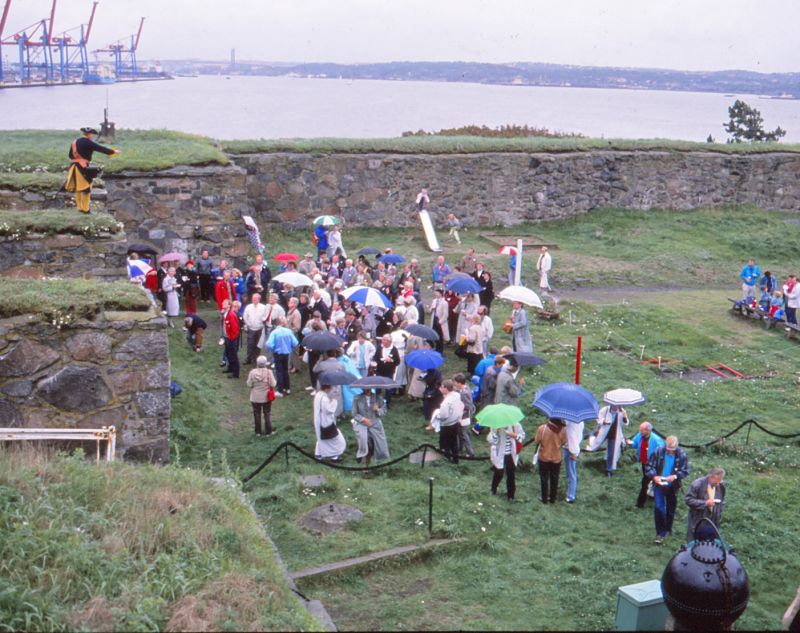
Anders explaining how the diving results are illustrated
by the rough outline model of the excavation area, on the ground

Already here the list of Sponsor's were impressively long.
All companies got their names displayed, painted on a piece of wood
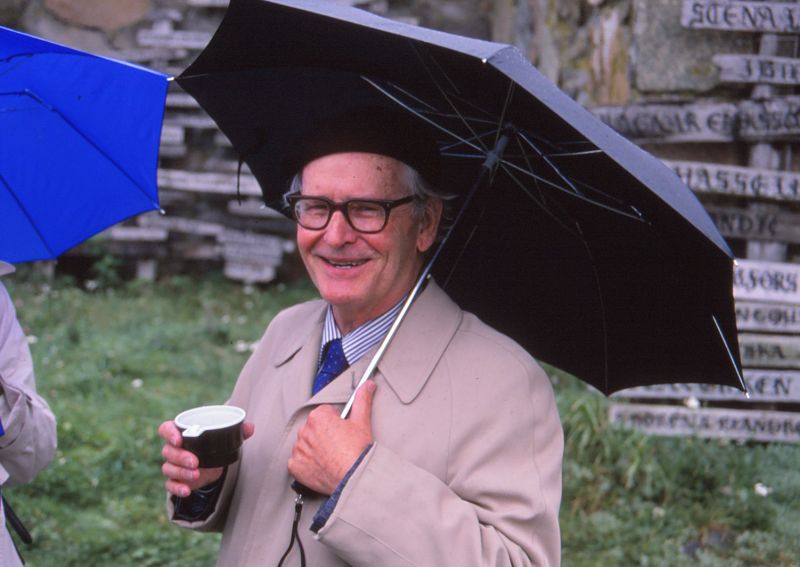
Porcelain expert Professor em Bo Gyllensvärd was one of the many knowledgeable experts
that helped creating a solid knowledge foundation for the work.
The results of the 1986 and 1987 seasons influenced the decision that in 1988 concentrate the work around the large remains of the vessel. In July 1988, an area of 64 square meters was exposed around them, and details from the stern could be identified.
In the July 1989 excavation season the two largest pieces of the stern were recovered. A further 44 square meters of the sea bed was investigated to an average depth of 60 centimeters. A stack containing thirteen unbroken porcelain plates was found and recovered. That was the first find of this type.
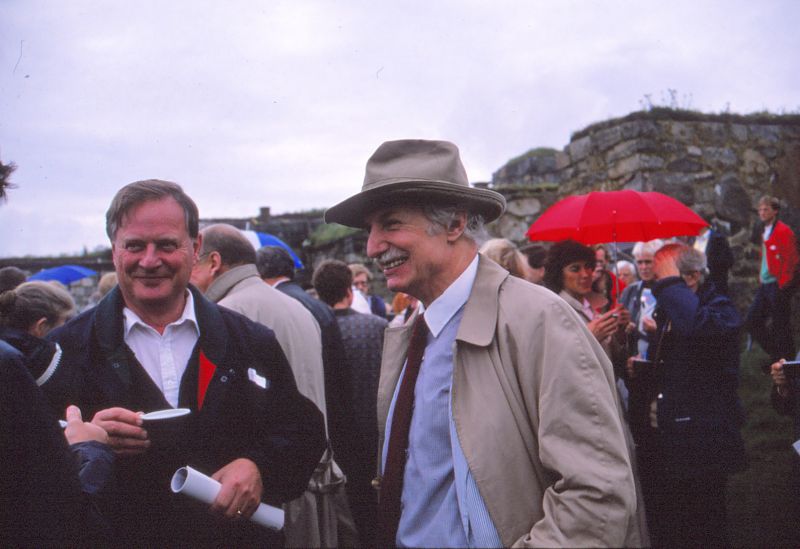
Porcelain expert Sir David Sanctuary Howard enjoyed the outing despite the very British weather
and was as curious as we all, about what would come out of this excavation.

Host at this particular event was Björn Gremner, CEO, Antikwest AB (left).
In July 1990, the work was concentrated in the area where the recovered pieces of the stern had lain. A further 84 square meters of the sea bed was investigated, and pieces of the vessel's keel were found where the sternpost had lain. The location on the sea bed of the vessel as a whole could thus be determined.
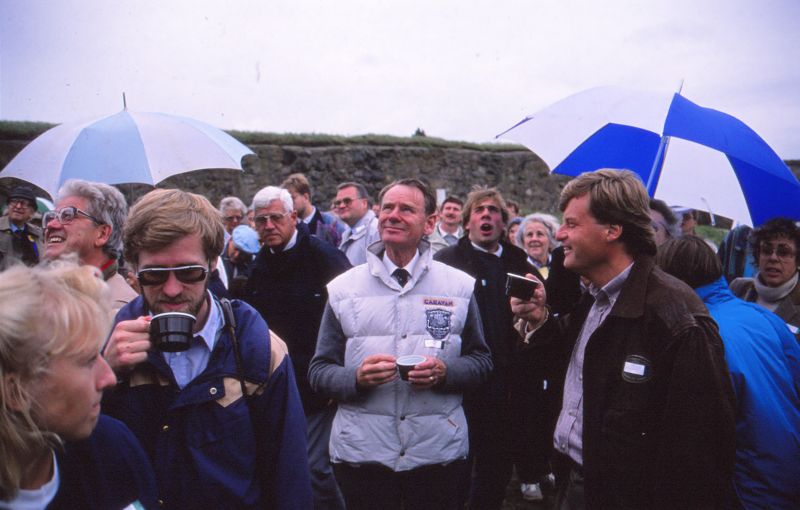
Chairman of the Gotheborg Excavation Foundation,
Professor Jörgen Weibull, Faculty of History, Gothenburg University.

Professor of History em Jörgen Weibull and chairman of the Gotheborg Excavation Foundation
During the six years between 1986 and 1991 hundreds of public event was held at the island, by and large creating the entire good will capital the later Ship's reconstruction project that were to follow were to build upon.
In July of 1991 which was the sixth and penultimate excavation season work continued to expose the area around the vessel's keel, together with documentation of pieces of the vessel that were recovered. The number of finds was still large. In addition to personal effects, packing material, spices, tea and porcelain, a 21.6-kilo (c. 40 pounds) ingot of tutanego was recovered. An area of 84 square meters was investigated to an average depth of 60 centimeters.

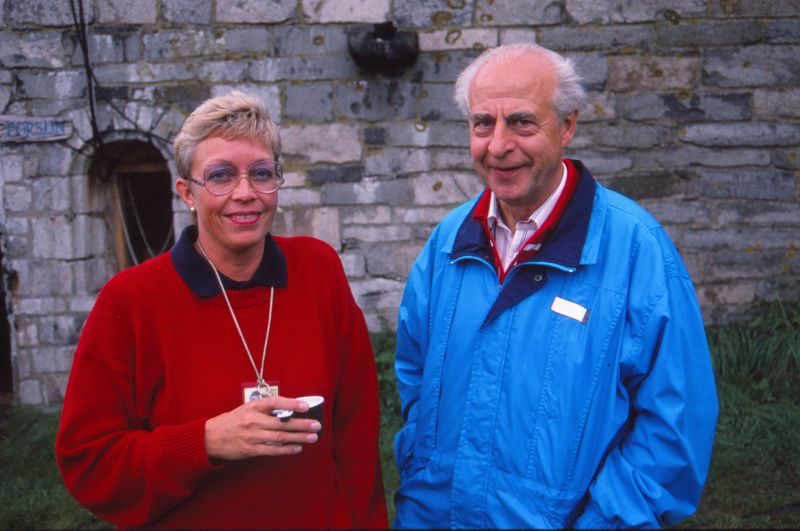
Berit Wästfelt, excavation porcelain manager, and Karl Hugosson, AntikWest AB

Porcelain from the East Indiaman Gotheborg, found during the excavation. All in all, the excavation would yield about 6 tonne's of porcelain shards.
Of the total area of 1,008 square meters, 428 square meters were investigated up to the end of the 1991 season. More than 5,000 individual objects were registered.
The quantities of finds and their distribution over the area gives a picture of the vessel's location on the sea bed and its deterioration through 250 years. Variations in the volume of finds give a good picture of the cargo and how it was packed.
A large portion of what has been recovered comprises of bits of broken porcelain that all in all weigh more than six tons. Over 300 undamaged pieces of porcelain has been recovered. In the book Porcelain from the East Indiaman Götheborg, Berit Wästfelt, Bo Gyllensvärd and Jörgen Weibull record this material up to the end of the 1989 season.
In 2003 the Gotheborg (Hunnebådan) rock was blasted away by the harbor authorities to improve navigation and the water depth increased from about 6 meters to 14 by dredging the remaining areas.
All that was left of the East Indiaman Götheborg and its cargo is thus most probably now either salvaged or lost forever. All finds from our excavations are in the possession of Swedish public museums.
The number of authentic and properly identified complete pieces of porcelain from this - the only excavated Swedish East Indiaman is and will thus remain very few and it is also unavoidable that many of our questions will remain unanswered.